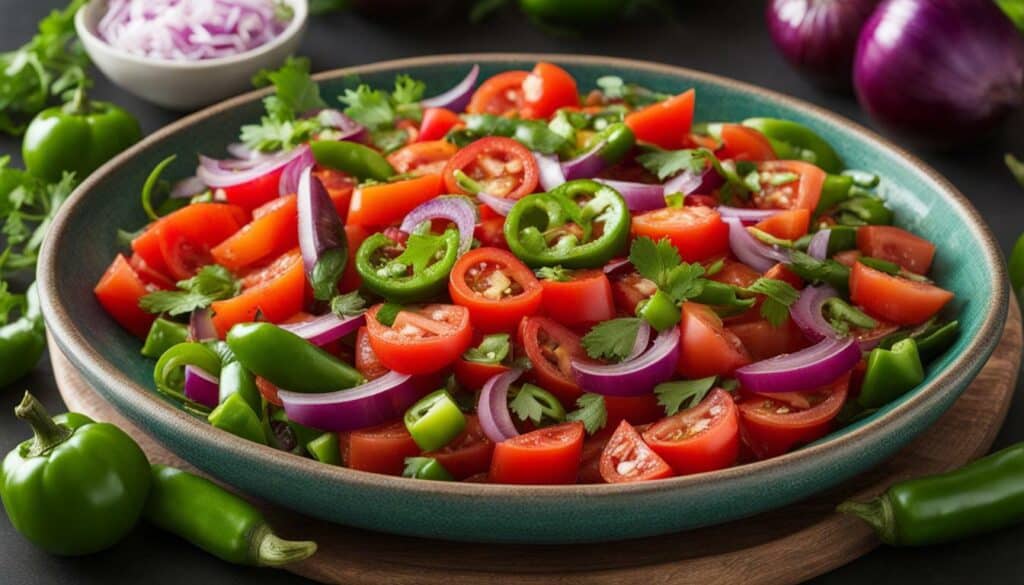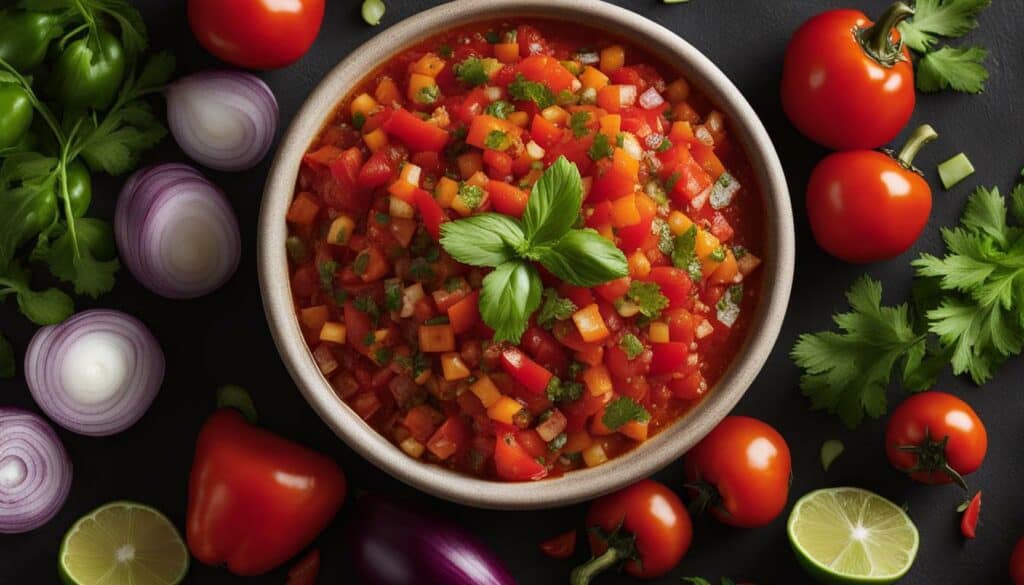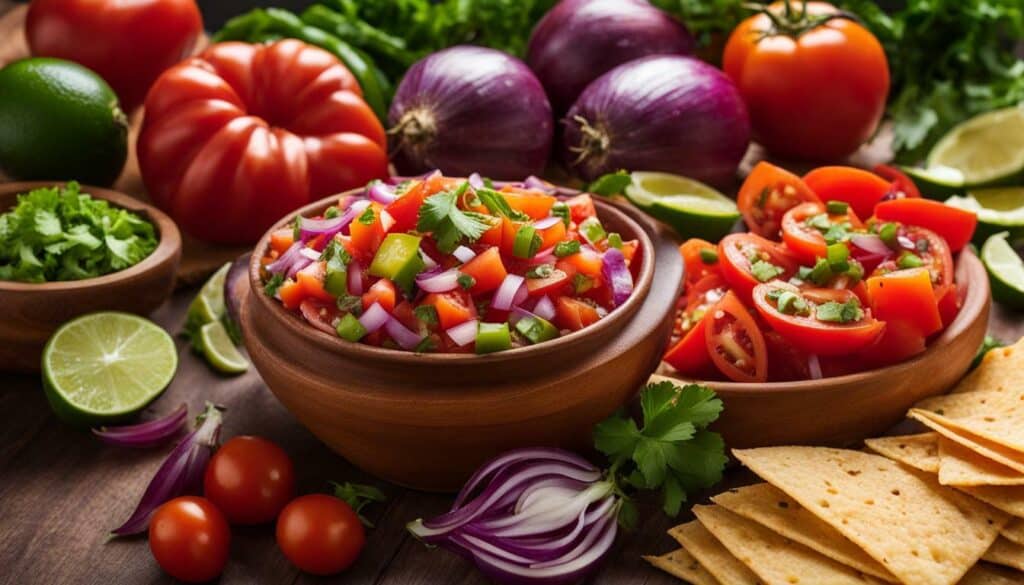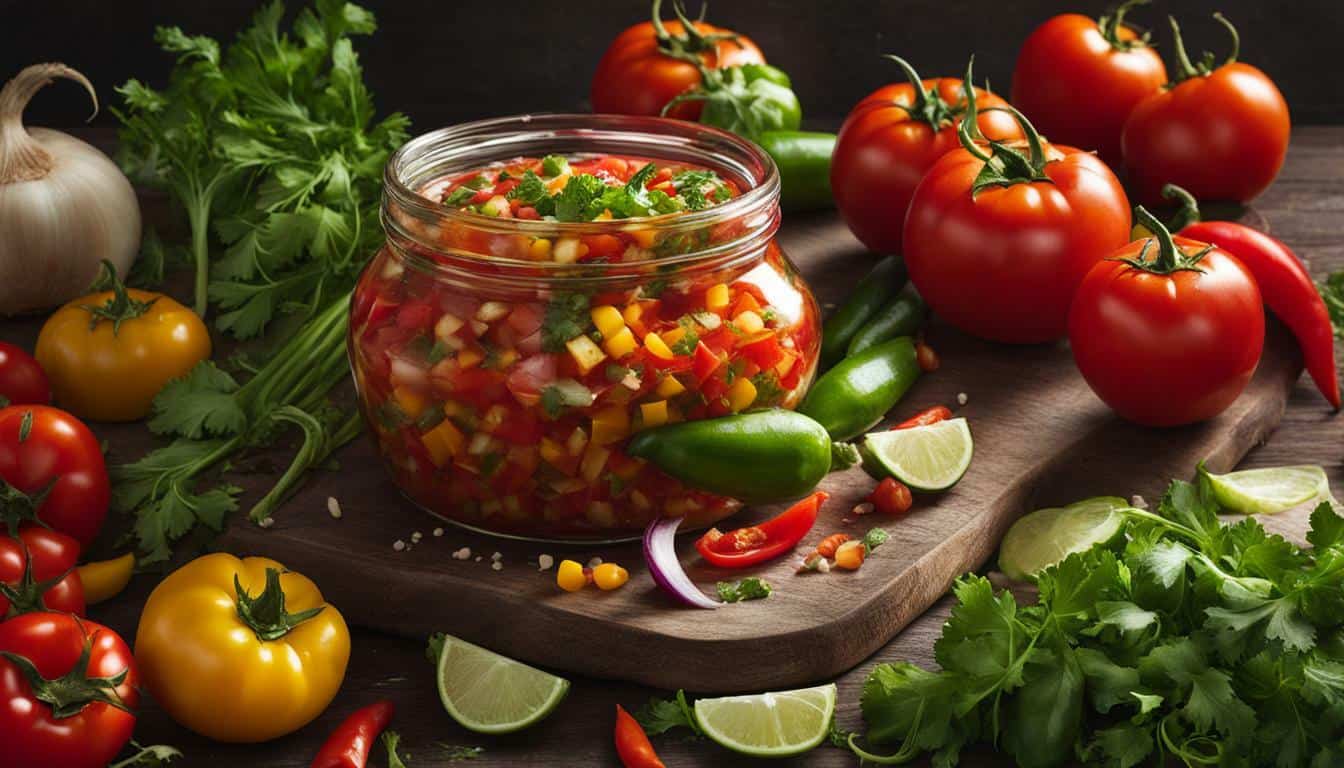Welcome to the world of salsa nutrition! If you’re a health foodie looking to dive into the wholesome goodness of salsa, you’ve come to the right place. Salsa is not just a flavorful condiment; it’s also packed with nutritional benefits that can enhance your overall well-being.
Did you know that salsa is rich in vitamin C? This essential nutrient helps boost your immune system, prevents heart disease, and promotes healthy aging. With salsa, you can enjoy a tasty way to strengthen your body from the inside out.
But the benefits don’t stop there. Salsa’s fiber content helps stabilize blood sugar levels, making it a suitable choice for individuals with type 2 diabetes. Plus, salsa’s hydrating properties and lycopene content may provide protection against cancer.
If you’re looking to shed some pounds, salsa can be your secret weapon. It’s low in calories, fat-free, and can help burn fat. Say goodbye to bland diet food and hello to a flavorful salsa that adds a burst of taste without sabotaging your weight loss goals.
When it comes to heart health, salsa is a true champion. It’s cholesterol-free and low in calories, making it a heart-friendly condiment. But don’t worry, it doesn’t sacrifice flavor. Salsa adds a zing to your meals while keeping your heart happy.
Let’s talk about the nutritional value of salsa. It’s a good source of potassium and quercetin, which are important for maintaining healthy blood pressure and reducing inflammation. Salsa also provides a dose of citric acid, which aids in digestion and promotes nutrient absorption.
Key Takeaways:
- Salsa is rich in vitamin C, promoting heart health and healthy aging.
- Its fiber content helps stabilize blood sugar levels, making it suitable for individuals with type 2 diabetes.
- Salsa’s hydrating properties and lycopene content may provide protection against cancer.
- It is a low-calorie, fat-free condiment that can help with weight loss.
- Salsa is cholesterol-free and beneficial for heart health.
So grab your favorite tortilla chips, eggs, or fish, and enjoy the delightful and nutritious world of salsa. Whether you’re looking for a tasty topping or a versatile ingredient, salsa is here to add a flavorful twist to your meals. Stay tuned for more insight into the wonderful world of salsa nutrition!
The Health Benefits of Salsa
Salsa isn’t just a flavorful condiment, it’s also a nutritional powerhouse packed with health benefits. Whether you enjoy it mild or spicy, this popular Mexican sauce offers a range of advantages that can support your overall well-being.
One of the standout benefits of salsa is its high vitamin C content. Vitamin C is a powerful antioxidant that helps prevent heart disease and promotes healthy aging. It also boosts your immune system and supports collagen production, which is essential for maintaining healthy skin and joints.
“Salsa is not only delicious but also a great way to incorporate more vegetables into your diet,” says nutritionist Jane Davis. “The combination of tomatoes, onions, peppers, and herbs in salsa provides a wide range of vitamins and minerals that are beneficial for your health.”
Additionally, salsa’s fiber content helps stabilize blood sugar levels, making it an ideal choice for individuals with type 2 diabetes. The fiber slows down the absorption of sugar into the bloodstream, preventing sudden spikes and crashes. It also promotes a feeling of fullness, which can aid in weight management.
| Nutrient | Amount per Serving |
|---|---|
| Calories | 20 |
| Total Fat | 0g |
| Sodium | 150mg |
| Carbohydrates | 5g |
| Fiber | 1g |
| Protein | 1g |
Moreover, salsa is hydrating and can potentially protect against cancer. The tomatoes in salsa contain lycopene, a powerful antioxidant that has been shown to reduce the risk of certain cancers, including prostate and lung cancer. Lycopene also provides the vibrant red color that is characteristic of salsa.

Salsa is not only a delicious way to enhance the flavor of your meals but also a healthy addition to your diet. Its low-calorie and low-fat nature make it a weight-loss-friendly condiment. Plus, it’s cholesterol-free and full of flavor, making it a great choice for heart health. Salsa is also rich in potassium and quercetin, both of which have numerous health benefits.
With its essential nutrients like calcium, magnesium, and vitamins A and E, salsa offers a variety of micronutrients that are essential for overall health. However, it’s important to be mindful of store-bought salsa varieties that can be high in sodium and sugar. Read labels carefully and opt for homemade or low-sodium options whenever possible.
Enjoy salsa with chips, eggs, fish, or as a topping for salads. Its versatility allows you to incorporate it into a wide range of dishes, adding a burst of flavor and nutrition. So, grab a jar of salsa and indulge in its delicious and healthful benefits!
Exploring Salsa Ingredients
Let’s take a closer look at the ingredients that make salsa a delicious and nutritious choice. Salsa is a versatile condiment that can be made with a variety of ingredients, but the key components that contribute to its nutritional value remain consistent. The main ingredient in most salsas is tomatoes, which are packed with vitamins and minerals. Tomatoes are rich in vitamin C, which helps boost the immune system and promotes healthy aging. They are also a good source of vitamin A, potassium, and lycopene, a powerful antioxidant that may help protect against cancer.
In addition to tomatoes, salsa often includes ingredients like onions, peppers, cilantro, and garlic. These ingredients not only add flavor to the salsa but also provide their own health benefits. Onions, for example, are high in antioxidants and may help reduce the risk of heart disease. Peppers, especially hot peppers like jalapenos, are rich in capsaicin, which has been shown to boost metabolism and aid in weight loss. Cilantro and garlic both have antibacterial and anti-inflammatory properties, making them beneficial for overall health.
Salsa can be customized to suit individual tastes and preferences. Some people like to add fruits such as mangoes or pineapples to their salsa, which adds natural sweetness and additional vitamins and minerals. Others prefer to include spices like cumin or paprika for added flavor and depth. The beauty of salsa is that it can be tailored to suit different dietary needs and flavor profiles.
| Ingredient | Health Benefits |
|---|---|
| Tomatoes | Rich in vitamin C, vitamin A, potassium, and lycopene |
| Onions | High in antioxidants, may help reduce the risk of heart disease |
| Peppers | Rich in capsaicin, may boost metabolism and aid in weight loss |
| Cilantro | Has antibacterial and anti-inflammatory properties |
| Garlic | Has antibacterial and anti-inflammatory properties |
So, whether you prefer a classic tomato-based salsa or like to experiment with different ingredients, salsa is a nutritious choice that can enhance the flavor of any dish. Its combination of vitamins, minerals, antioxidants, and fiber make it a versatile condiment that can contribute to overall health and well-being.

Want to enjoy the freshest, most nutritious salsa? Follow this easy homemade salsa recipe and savor the flavors of homemade goodness. Not only is making your own salsa a fun and rewarding experience, but it also allows you to control the quality of ingredients and customize the taste to your liking. This recipe is perfect for those who appreciate the vibrant flavors of fresh vegetables and herbs.

To make this delicious homemade salsa, you will need the following ingredients:
| Ingredients: | Quantity: |
|---|---|
| Fresh tomatoes | 4 large |
| Red onion | 1 small |
| Jalapeno pepper | 1 |
| Fresh cilantro | 1/4 cup |
| Lime juice | 2 tablespoons |
| Garlic | 2 cloves |
| Ground cumin | 1/2 teaspoon |
| Salt | 1/2 teaspoon |
Instructions:
- Start by preparing the tomatoes. Remove the core and dice them into small pieces. Place them in a large mixing bowl.
- Finely chop the red onion, jalapeno pepper (remove seeds for a milder flavor), and fresh cilantro. Add them to the bowl with the tomatoes.
- Mince the garlic cloves and add them to the bowl.
- Add the lime juice, ground cumin, and salt to the bowl.
- Gently mix all the ingredients together until well combined. Taste and adjust the seasonings if needed.
- Cover the bowl and refrigerate for at least 30 minutes to allow the flavors to meld together.
- Once chilled, your homemade salsa is ready to be enjoyed with tortilla chips, as a topping for grilled meats, or as a fresh addition to tacos and salads.
So why settle for store-bought salsa when you can create your own homemade masterpiece? With this simple recipe, you can experience the joy of making something from scratch and relish in the vibrant flavors of fresh ingredients. Whether you’re hosting a party or simply craving a healthy snack, this homemade salsa is sure to satisfy your taste buds and nourish your body with its nutritional goodness.
Salsa’s Role in Weight Loss
Looking to shed some pounds? Discover how salsa can be your secret weapon for weight loss without sacrificing taste. Salsa is a low-calorie condiment that can add a burst of flavor to your meals while helping you achieve your weight loss goals.
One of the key reasons why salsa is great for weight loss is its low calorie content. A typical serving of salsa contains only about 10 to 15 calories, depending on the brand and variety. This means you can enjoy a generous portion of salsa without worrying about adding extra calories to your plate.
Salsa is also fat-free, making it an excellent choice for those watching their fat intake. By swapping high-fat condiments like mayonnaise or creamy dressings with salsa, you can significantly reduce your calorie and fat intake, helping you create a calorie deficit for weight loss.
Another benefit of salsa for weight loss is its high water content. Salsa is made primarily from tomatoes, which have a high water content. This not only helps keep you hydrated but also contributes to a feeling of fullness. Adding salsa to your meals can help curb your appetite, making you feel more satisfied with fewer calories consumed.
| Nutritional Content of Salsa (per serving) | |
|---|---|
| Calories | 10-15 |
| Fat | 0g |
| Sodium | 200-300mg |
| Carbohydrates | 2-4g |
| Sugar | 1-2g |
| Fiber | 1-2g |
| Protein | 0-1g |
Salsa can also be a great substitute for high-calorie, high-fat dips and spreads. Instead of reaching for fatty cheese dips or calorie-laden spreads, pair your snacks with salsa. Whether it’s tortilla chips, vegetable sticks, or whole-grain crackers, salsa can elevate the taste of your snacks while keeping the calorie content in check.
So, if you’re looking to lose weight or maintain a healthy weight, consider incorporating salsa into your diet. It’s a versatile and delicious condiment that can enhance the flavor of your meals without piling on the calories. Just remember to opt for homemade or low-sodium, low-sugar store-bought varieties to maximize the weight loss benefits of salsa.

Let’s uncover the nutritional value of salsa and discover why it’s more than just a tasty addition to your meals. Salsa is a nutritional powerhouse that offers numerous health benefits. It is not only delicious but also packed with essential nutrients that can support your overall well-being.
One of the key nutritional benefits of salsa is its high vitamin C content. Vitamin C is an antioxidant that helps prevent heart disease and promotes healthy aging. It strengthens the immune system and aids in collagen production, which is essential for healthy skin, hair, and nails.
Salsa also contains fiber, which is important for stabilizing blood sugar levels. This makes it a suitable condiment for individuals with type 2 diabetes. The fiber content in salsa also aids in digestion and promotes a healthy gut, contributing to overall digestive health.

| Nutrient | Amount per Serving (1 cup) |
|---|---|
| Calcium | 30mg |
| Magnesium | 20mg |
| Vitamin A | 1000IU |
| Vitamin E | 2mg |
“Salsa is not only low in calories and fat, but it also provides a burst of flavor that can elevate any dish.”
Salsa is also hydrating due to its high water content, helping to keep you hydrated throughout the day. Additionally, salsa contains lycopene, an antioxidant that gives tomatoes their vibrant red color. Lycopene has been linked to a reduced risk of certain cancers, particularly prostate cancer.
Salsa’s benefits extend beyond its nutritional content. It is a low-calorie condiment that can help burn fat when included in a balanced diet. Salsa is also beneficial for heart health as it is cholesterol-free and low in calories. It contains potassium, which supports heart health and helps regulate blood pressure. The presence of quercetin, a flavonoid antioxidant, further enhances its cardiovascular benefits.
In conclusion, salsa is more than just a tasty addition to your meals. It is a nutritional powerhouse that can support your overall health. Whether enjoyed with chips, eggs, fish, or as a topping for salads, salsa is a delicious and versatile condiment that adds flavor and nutritional value to your dishes.
Salsa’s Antioxidant Power
Did you know that salsa brings a powerful dose of antioxidants to your plate? Let’s explore how this vibrant condiment can boost your health.
Salsa, with its colorful blend of tomatoes, onions, and peppers, is a nutritional powerhouse that provides a wide array of health benefits. One of the key reasons why salsa is so beneficial for your health is its high antioxidant content. Antioxidants are compounds that help protect your cells from damage caused by free radicals, which are unstable molecules that can lead to chronic diseases like cancer and heart disease.

In addition to its antioxidant properties, salsa contains lycopene, a potent antioxidant that gives tomatoes their red color. Lycopene has been linked to a reduced risk of certain cancers, including prostate and breast cancer. Furthermore, salsa’s ingredients, such as onions and garlic, are rich in sulfur compounds that have been shown to have anti-cancer properties.
| Antioxidant Content of Salsa Ingredients | Antioxidant |
|---|---|
| Tomatoes | Lycopene |
| Onions | Quercetin |
| Garlic | Allicin |
By incorporating salsa into your diet, you can easily increase your antioxidant intake and support your overall health. Whether you enjoy it with tortilla chips, as a topping for grilled fish, or as a zesty addition to your scrambled eggs, salsa offers a delicious way to boost your antioxidant levels and add extra flavor to your meals.
Macro and Micronutrients in Salsa
Salsa isn’t just tasty, it’s also a nutrient-packed ally. Learn about the essential macro and micronutrients that salsa brings to the table.
When it comes to macro and micronutrients, salsa is a true powerhouse. This vibrant condiment contains a variety of health-enhancing components that can support overall well-being.
Let’s start with the macro side of things. Salsa is low in calories and fat, making it a guilt-free addition to your meals. It’s also a good source of carbohydrates, providing energy to fuel your activities. But that’s not all—salsa is chock-full of fiber, which aids in digestion and helps keep you feeling satisfied.
On the micronutrient front, salsa packs a punch. It contains significant levels of vitamins and minerals that are beneficial for your body. For example, salsa is rich in vitamin C, which supports a healthy immune system and collagen production. It also contains vitamins A and E, which contribute to healthy skin and eyes.
| Nutrient | Amount per Serving |
|---|---|
| Calcium | 2% DV |
| Magnesium | 2% DV |
| Potassium | 4% DV |
In addition to these vitamins, salsa contains essential minerals like calcium, magnesium, and potassium. These minerals are crucial for maintaining healthy bones, muscles, and nerve function. Packed with antioxidants, salsa fights against harmful free radicals in the body, potentially reducing the risk of chronic diseases.
So, the next time you’re reaching for a condiment, consider adding a dollop of salsa to your plate. Not only will it bring a burst of flavor to your meal, but it will also provide you with a range of beneficial macro and micronutrients.

While salsa offers a plethora of health benefits, it’s important to be mindful of the sodium and sugar content in certain store-bought options. Some commercially-produced salsas can be high in sodium, which can contribute to increased blood pressure and other health issues. Similarly, certain varieties may contain added sugars, which can be detrimental to overall health and wellness.
When shopping for salsa, it’s crucial to read the labels carefully and choose options that are lower in sodium and sugar. Opting for low-sodium or no added sugar varieties can help you enjoy the nutritional benefits of salsa without compromising your health goals. Alternatively, you can try making your own homemade salsa, allowing you to control the amount of sodium and sugar that goes into the recipe.
High Sodium Salsa
Sodium is an essential mineral that plays a role in maintaining proper fluid balance in the body and supporting nerve and muscle function. However, excessive sodium intake can lead to health problems, including increased blood pressure and a higher risk of heart disease. Some salsa brands may contain higher levels of sodium, making it important for individuals monitoring their sodium intake to choose low-sodium options or limit their portion sizes. It’s crucial to be aware of the sodium content in store-bought salsas and choose wisely to maintain a balanced diet.
High Sugar Salsa
While salsa is generally considered a healthier alternative to other condiments, it’s essential to be cautious of added sugars in certain varieties. Excessive sugar consumption can lead to weight gain, an increased risk of chronic diseases like diabetes, and tooth decay. When selecting store-bought salsa, check the ingredient list for added sugars such as corn syrup or other sweeteners. Opting for salsa brands that use natural ingredients and avoid the addition of sugars can help you enjoy the flavors without compromising your health.
By being mindful of the sodium and sugar content in salsa, you can make informed choices that allow you to enjoy this flavorful condiment while maintaining a healthy diet. Whether you opt for homemade salsa or store-bought options, it’s always a good idea to check the nutrition labels and select options that align with your dietary needs and goals.
Salsa Pairings and Serving Suggestions
Ready to jazz up your meals with salsa? Discover creative ways to enjoy this zesty condiment with a variety of dishes. Salsa is a versatile and flavorful addition to many recipes, adding a burst of freshness and a spicy kick. Whether you prefer mild or hot salsa, there are endless possibilities for incorporating it into your meals. Here are some ideas to get you started:
- Classic Chips and Salsa: Serve salsa with crispy tortilla chips for a classic snack or appetizer. The tangy flavors of salsa complement the crunchy texture of the chips perfectly.
- Egg-cellent Breakfast: Add a spoonful of salsa to scrambled eggs or omelets for a flavorful twist. The acidity of the salsa balances the richness of the eggs, creating a delicious combination.
- Fish Tacos: Top your fish tacos with salsa for a burst of freshness. The vibrant flavors of salsa pair beautifully with the delicate flavors of fish, adding a refreshing element to every bite.
- Salsa Salad: Create a salsa-inspired salad by mixing diced tomatoes, onions, cilantro, and lime juice. Use this refreshing salsa salad as a topping for grilled chicken or shrimp, or enjoy it as a side dish.
- Guacamole Upgrade: Take your guacamole to the next level by adding a spoonful or two of salsa. The combination of creamy avocado and zesty salsa creates a delicious dip that is perfect for parties or snacking.
Experiment with different salsa varieties, such as mango or pineapple salsa, to add a fruity twist to your dishes. Salsa can also be used as a marinade for grilled meats or as a topping for baked potatoes or roasted vegetables. Get creative and let salsa be your secret weapon in the kitchen.
Remember, when using store-bought salsa, be mindful of the sodium and sugar content. Opt for low-sodium and low-sugar options or make your own salsa at home to control the ingredients.
So, why not give salsa a try and elevate your meals with its vibrant flavors? Whether you’re a salsa aficionado or new to this tangy condiment, there are endless possibilities to explore. Get ready to dip, spoon, and savor the deliciousness of salsa!

Salsa isn’t just a flavor enhancer; it’s a heart-healthy choice that can spice up your meals without adding unwanted cholesterol or calories. With its vibrant colors and fresh ingredients, salsa is not only a delicious condiment but also a nutritional powerhouse. Let’s take a closer look at how salsa can benefit your heart health.
One of the key reasons salsa is good for your heart is its high vitamin C content. Vitamin C is an essential antioxidant that helps prevent heart disease and promotes healthy aging. By neutralizing harmful free radicals, vitamin C protects your heart from damage and reduces the risk of developing cardiovascular problems.
Additionally, salsa can help stabilize blood sugar levels, making it suitable for individuals with type 2 diabetes. The fiber present in salsa slows down the absorption of sugars into the bloodstream, preventing spikes in blood sugar. This can improve insulin sensitivity and help manage diabetes more effectively.

Furthermore, salsa is hydrating and may have protective effects against cancer. The main antioxidant found in salsa is lycopene, which gives tomatoes their bright red color. Lycopene has been linked to a decreased risk of certain cancers, including prostate, lung, and stomach cancer. So, by enjoying salsa, you’re not only adding flavor but also potentially boosting your body’s defense against cancer.
Salsa is a great condiment for those looking to shed a few pounds or maintain a healthy weight. It is low in calories and fat, making it a perfect addition to a weight-loss or weight-management diet. By substituting high-calorie and high-fat dressings or sauces with salsa, you can cut down on unnecessary calories without sacrificing flavor.
In summary, salsa offers a range of heart-healthy benefits. From promoting heart health and stabilizing blood sugar levels to potentially protecting against cancer, salsa is a nutritious and delicious addition to any meal. So, next time you’re reaching for a condiment, remember to reach for salsa and give your heart a flavorful boost.
Conclusion
In conclusion, salsa nutrition is a winning combination of health benefits, essential nutrients, and incredible flavors. So go ahead and embrace the goodness of salsa in your culinary adventures.
Salsa packs a powerful punch of vitamin C, a key nutrient that helps prevent heart disease and promotes healthy aging. With its fiber content, salsa also helps stabilize blood sugar levels, making it a suitable choice for individuals with type 2 diabetes.
Not only is salsa hydrating, but it also contains lycopene, a powerful antioxidant that may offer protection against cancer. Additionally, salsa can help with weight loss due to its low-calorie and fat-free nature, while still providing a burst of flavor.
When it comes to essential nutrients, salsa is a superstar. It is a good source of potassium and quercetin, both of which have numerous health benefits. Salsa also provides a dose of citric acid, which aids in digestion. Furthermore, it contains calcium, magnesium, vitamins A and E, and other vital nutrients that contribute to overall well-being.
However, it’s important to be mindful of store-bought salsa varieties that may be high in sodium and sugar. To ensure you’re making a healthy choice, be sure to read labels carefully and opt for homemade or low-sodium options when possible.
Enjoying salsa doesn’t have to be limited to just chips and dips. Get creative and explore different ways to incorporate salsa into your meals. Pair it with eggs for a flavorful breakfast, use it as a topping for fish or salads, or incorporate it into your favorite Mexican-inspired dishes. The possibilities are endless!
Overall, salsa is a delicious and nutritious condiment that can enhance the flavor of various dishes while providing a range of health benefits. So go ahead, grab your favorite salsa, and savor the goodness it brings to your plate.
FAQ
Q: Is salsa a healthy condiment?
A: Yes, salsa is a healthy condiment that offers numerous health benefits.
Q: What are the health benefits of salsa?
A: Salsa promotes heart health, stabilizes blood sugar levels, and may protect against cancer.
Q: What are the key ingredients in salsa?
A: Salsa typically includes tomatoes, onions, peppers, and various herbs and spices.
Q: Can I make salsa at home?
A: Absolutely! Making homemade salsa is simple and allows you to control the ingredients and customize the flavor.
Q: Is salsa suitable for weight loss?
A: Yes, salsa is a weight-loss-friendly condiment as it is low in calories and fat-free.
Q: What nutritional value does salsa offer?
A: Salsa is a good source of vitamin C, potassium, quercetin, and other essential nutrients.
Q: Does salsa contain antioxidants?
A: Yes, salsa contains antioxidants, particularly lycopene, which has potential cancer-fighting abilities.
Q: What macro and micronutrients are found in salsa?
A: Salsa provides potassium, quercetin, citric acid, and other beneficial macro and micronutrients.
Q: Are store-bought salsas high in sodium or sugar?
A: Some store-bought salsas can be high in sodium and sugar, so it’s important to read labels carefully to make healthier choices.
Q: How can I enjoy salsa?
A: Salsa can be enjoyed with chips, eggs, fish, or as a topping for salads, adding flavor to various dishes.
Q: Is salsa beneficial for heart health?
A: Yes, salsa is beneficial for heart health as it is cholesterol-free and low in calories.
What Are the Carbohydrate Content and Benefits of Salsa?
Salsa is a flavorful condiment that adds zest to any dish. It is low in carbohydrates, making it an excellent choice for those watching their carb intake. Packed with fresh ingredients like tomatoes, onions, and peppers, salsa is not just tasty but also nutritious. Its vibrant colors and rich flavors make carbohydrates in pictures look more appetizing and can be enjoyed guilt-free by health-conscious individuals.





Leave a Reply